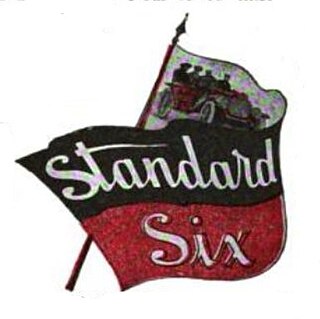
D. Napier & Son Limited was a British engineering company best known for its luxury motor cars in the Edwardian era and for its aero engines throughout the early to mid-20th century.

The Acme was a make of American automobiles made in Reading, Pennsylvania from 1903 to 1911. They were the successor of the Reber which was made from 1902 to 1903 by Reber Manufacturing.
The Lanchester Motor Company Limited was a car manufacturer located until early 1931 at Armourer Mills, Montgomery Street, Sparkbrook, Birmingham, and afterwards at Sandy Lane, Coventry England. The marque has been unused since the last Lanchester was produced in 1955. The Lanchester Motor Company Limited is still registered as an active company and accounts are filed each year, although as of 2014 it is marked as "non-trading".

The Knox Automobile Company was a manufacturer of automobiles in Springfield, Massachusetts, United States, between 1900 and 1914. Knox also built trucks and farm tractors until 1924. They are notable for building the very first modern fire engine in 1905.
Northern Manufacturing Company was a manufacturer of Brass Era automobiles in Detroit, Michigan, automobiles designed by Charles Brady King. Early advertising included catchy phrases such as "Utility is the Basis for Beauty" and "Built for Business" and the famous "Silent Northern".

The Pope-Toledo was the luxury marque of the Pope Motor Car Company founded by Colonel Albert A. Pope, and was a manufacturer of Brass Era automobiles in Toledo, Ohio between 1903 and 1909. The Pope-Toledo was the successor to the Toledo of the International Motor Car Company.
Smith & Mabley was an American veteran era importer of European automobiles and produced the American C. G. V. automobile in 1902, and the S & M Simplex automobile from 1904 to 1907, in New York City.

St. Louis Motor Carriage Company was a manufacturer of automobiles at 1211–13 North Vandeventer Avenue in St. Louis, Missouri, founded by George Preston Dorris and John L. French in 1898, with French taking charge of marketing and Dorris heading engineering and production. St. Louis Motor Carriage was the first of many St. Louis automakers and produced automobiles from 1899 to 1907.

The Premier Motor Manufacturing Company built the brass era and vintage Premier luxury automobile in Indianapolis, Indiana, from 1903 to 1925.

The Lexington was an automobile manufactured in Connersville, Indiana, from 1910 to 1927. From the beginning, Lexingtons, like most other Indiana-built automobiles, were assembled cars, built with components from many different suppliers. The Thoroughbred Six and Minute Man Six were popular Lexington models.

The Westcott was an automobile produced in Richmond, Indiana and Springfield, Ohio in the United States between 1909 and 1925 by the Westcott Motor Car Company. The car company was named for its founder, John Westcott.
Standard Motor Construction Company (1904-1905) was the successor to the U. S. Long Distance Automobile Company (1900-1903) of Jersey City, New Jersey. The American Veteran Era Long Distance automobile was developed into the Standard automobile in 1904.

The Standard Six was an American automobile manufactured in St. Louis, Missouri by the St. Louis Car Company from 1909 until 1910. The company initially built the French Mors cars under license as the American Mors from 1906 to 1909. In 1910, Standard Six manufacturing was moved to Wabash, Indiana where production ended in 1911.

The Union automobile was a vehicle manufactured by the Union Automobile Company from 1902 until 1905. It was designed by John William Lambert, who had developed the three-wheel Buckeye gasoline buggy in 1891. Over the next decade, Lambert substantially refined the vehicle, with modifications including an additional wheel, a more powerful engine, and a new transmission system. The Union Automobile Company was formed as a subsidiary of Lambert's Buckeye Manufacturing Company solely to manufacture the Union, which took its name from Union City, Indiana, the city where it was built and which endorsed its production. In total, the company built over three hundred Union automobiles, before development shifted to the Lambert automobile, the Union's successor.

The Metz Company was a pioneer brass era automobile maker established by Charles Herman Metz in Waltham, Massachusetts, from 1909 to 1922.

The Cole Motor Car Company was an early automobile maker based in Indianapolis, Indiana. Cole automobiles were built from 1908 until 1925. They were quality-built luxury cars. The make is a pioneer of the V-8 engine.

The Jackson Automobile Company was an American Brass Era automobile manufacturer located in and named for Jackson, Michigan. The company produced the Jackson from 1903 to 1923, the 1903 Jaxon steam car and the 1904 Orlo.
Holyoke was an American automobile company started in Holyoke, Massachusetts in 1899. The first car had a two-cylinder, 7 hp motor. The cars were designed by Charles Robert Greuter, born Philadelphia, PA, March 26, 1861, and educated St. Gallen and Winterthur, Switzerland. In 1900 the Springfield Republican reported: "The president of the Holyoke motor works is Charles R. Greuter, who started the business of making gasoline carriages and wagons about a year ago in the old Standard machine company building, and at present employs about 40 men." In 1903 the company was acquired by the Matheson Motor Car company. Greuter then served as a director of that company.
The Pierce Engine Company of Racine, Wisconsin, was the manufacturer of the brass era Pierce-Racine automobile. The company was founded in 1892 and produced automobiles from 1904 to 1910.
The Welch Motor Company was an American automobile company headquartered in Chelsea, Michigan. It started in 1901 and continued production of luxury vehicles until 1911 when it merged with General Motors.



















